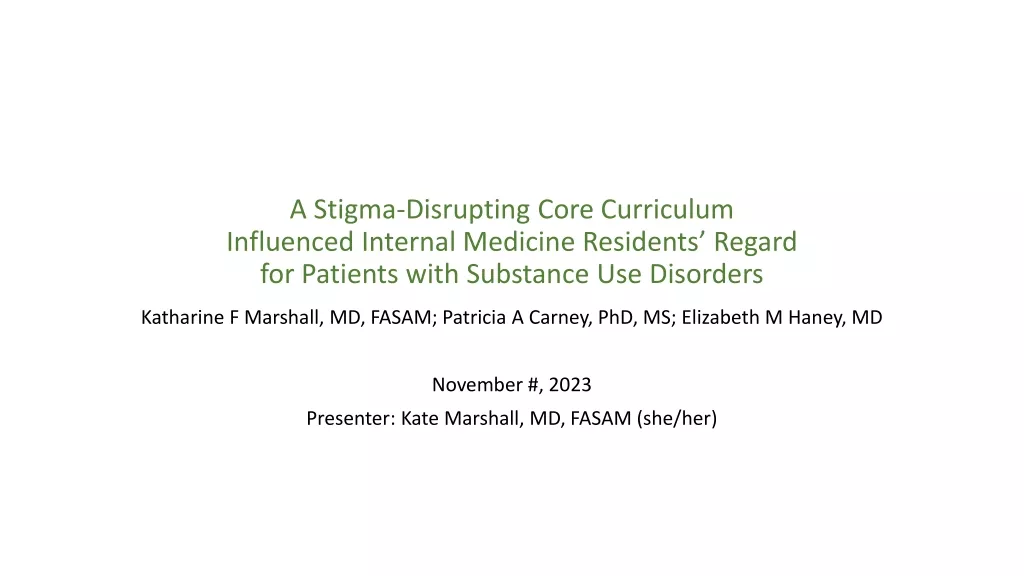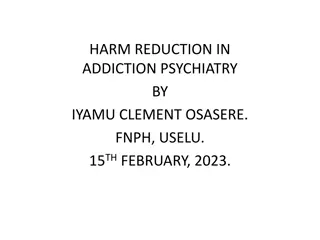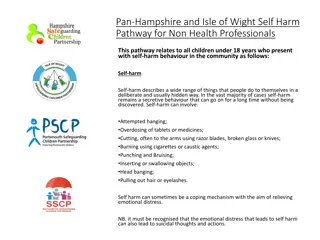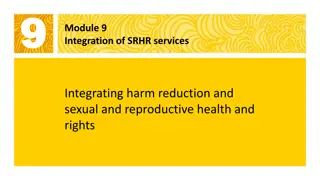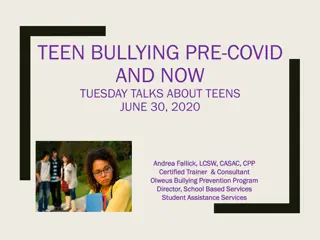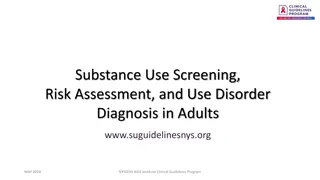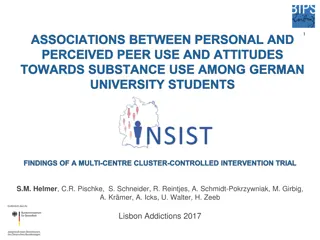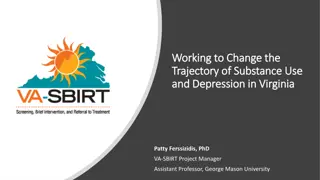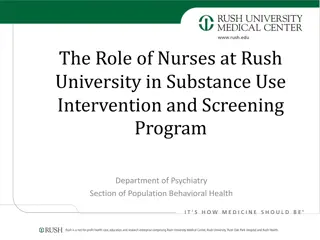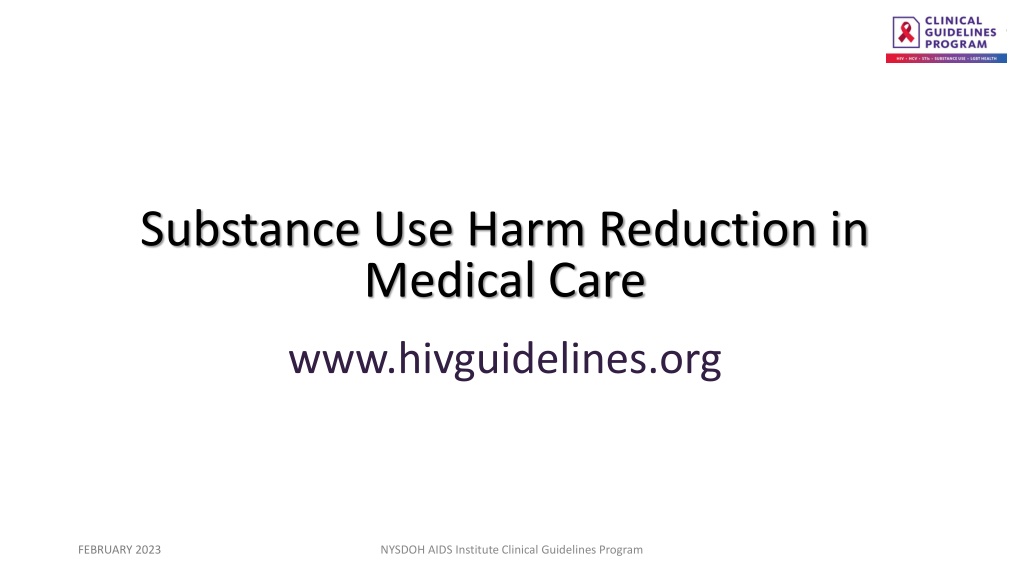
Substance Use Harm Reduction Strategies in Medical Care
Promote the adoption of practical harm reduction strategies to address the negative effects of substance use in medical care. The guidelines recommend offering medical care, harm reduction counseling, and collaborating with patients to set harm reduction goals. Clinicians are advised to educate patients on drug overdose risks and provide access to naloxone. Implementation of harm reduction strategies and overdose prevention measures is crucial to improving healthcare outcomes in substance use cases.
Download Presentation

Please find below an Image/Link to download the presentation.
The content on the website is provided AS IS for your information and personal use only. It may not be sold, licensed, or shared on other websites without obtaining consent from the author. If you encounter any issues during the download, it is possible that the publisher has removed the file from their server.
You are allowed to download the files provided on this website for personal or commercial use, subject to the condition that they are used lawfully. All files are the property of their respective owners.
The content on the website is provided AS IS for your information and personal use only. It may not be sold, licensed, or shared on other websites without obtaining consent from the author.
E N D
Presentation Transcript
Substance Use Harm Reduction in Medical Care www.hivguidelines.org FEBRUARY 2023 NYSDOH AIDS Institute Clinical Guidelines Program
Purpose of This Guideline Purpose of This Guideline Promote adoption of practical harm reduction strategies to reduce the negative consequences associated with drug and alcohol use. Increase awareness and use of NYSDOH and local/regional harm reduction resources. Support healthcare providers in recognizing and addressing the effects of stigma, which can pose a barrier to individuals seeking substance use treatment and harm reduction services. FEBRUARY 2023 NYSDOH AIDS Institute Clinical Guidelines Program www.hivguidelines.org
Recommendations: Recommendations: Implementing Substance Use Harm Reduction Implementing Substance Use Harm Reduction For patients who use substances, whether or not they are engaged in SUD treatment, clinicians should continue to offer medical care, including HCV and HIV screening and treatment, HIV PrEP, and HIV PEP, as indicated. (A3) Clinicians should offer or refer for harm reduction counseling and services, including counseling on safer substance use. (A3) To assist in harm reduction and treatment planning, clinicians should ask patients about all of the substances they use, methods of use, use networks, and the role and effects of substance use in their daily lives. (A3) Clinicians should collaborate with patients to set specific harm reduction/treatment goals, recognizing that goals other than full abstinence, such as reduced or safer use, are acceptable. (A3) To reduce harms associated with drug injection, clinicians should refer patients to a New York State Authorized Syringe Exchange Site (A2) and advise patients against sharing and reusing equipment given the associated risks (A3). FEBRUARY 2023 NYSDOH AIDS Institute Clinical Guidelines Program www.hivguidelines.org
Recommendations: Recommendations: Overdose Prevention Overdose Prevention Clinicians should educate patients on the risks of drug overdose, especially fentanyl overdose, and discuss risk reduction strategies, which may include: Avoid using drugs alone (A3) Assume opiate products will contain fentanyl and stimulants and counterfeit pills may contain fentanyl (A3) Use drugs in small amounts to start (A3) Carry naloxone (A2) Clinicians should offer or refer to an NYSDOH-Registered Opioid Overdose Prevention Program for fentanyl test strips and instructions on their use. (B3) Clinicians should ensure that patients who use drugs have access to NLX, are familiar with its use to reverse an overdose, and either prescribe the 4 mg NLX nasal spray formulation with refills or refer the patient to an NYSDOH-Registered Opioid Overdose Prevention Program for NLX. (A3) FEBRUARY 2023 NYSDOH AIDS Institute Clinical Guidelines Program www.hivguidelines.org
Recommendations: Recommendations: Pharmacologic Treatment Pharmacologic Treatment When indicated, clinicians should offer pharmacologic treatment for patients with an SUD. (A3) See the NYSDOH AI guidelines Treatment of Opioid Use Disorder and Treatment of Alcohol Use Disorder. Clinicians should continue to prescribe SUD treatment for patients who continue or resume use. (A3) Key Point: If the criminal justice system, child welfare services, or other similar entities discontinue an individual s OUD treatment plan, clinicians can advocate for continuation of their patient s pharmacologic treatment plan. FEBRUARY 2023 NYSDOH AIDS Institute Clinical Guidelines Program www.hivguidelines.org
Xylazine in the Nonprescription Drug Supply in New Xylazine in the Nonprescription Drug Supply in New York State York State Xylazine, a non-opioid sedative used in animals, has increasingly been found in the nonprescription drug supply, frequently mixed with fentanyl. Known as tranq or tranq dope when combined with heroin or fentanyl, xylazine has severe central nervous system depressant effects, and use may cause skin and soft tissue wounds, including ulceration. For more information and harm reduction strategies, see the NYSDOH fact sheet: Xylazine: What Clinicians Need to Know. FEBRUARY 2023 NYSDOH AIDS Institute Clinical Guidelines Program www.hivguidelines.org
Access to Harm Reduction Resources in Access to Harm Reduction Resources in New York State: Naloxone New York State: Naloxone Clinicians can prescribe NLX as a 4 mg nasal spray with refills for patients at risk of experiencing or witnessing an overdose. NLX is also available in a prefilled syringe for injection and a solution for intravenous infusion. Naloxone is covered by state Medicaid and the majority of private insurers. All pharmacies in New York State may dispense NLX without a patient-specific prescription to individuals who are at risk of an overdose or their family members or friends. The NYSDOH Naloxone Co-payment Assistance Program (N-CAP) covers up to $40.00 of any co-payment for NLX obtained through insurance. NYSDOH-Registered Opioid Overdose Prevention Programs, which include syringe exchange and drug treatment programs and the New York State Department of Corrections and Community Supervision, distribute free NLX. Mail-order: NLX is available through the online, mail-based platform NEXT Distro. FEBRUARY 2023 NYSDOH AIDS Institute Clinical Guidelines Program www.hivguidelines.org
Access to Harm Reduction Resources in Access to Harm Reduction Resources in New York State: Sterile Needles and Syringes New York State: Sterile Needles and Syringes Clinicians can prescribe sterile needles and syringes with refills. Licensed pharmacies, healthcare facilities, and healthcare providers can sell or furnish hypodermic needles or syringes to individuals 18 years old without a patient-specific prescription; see the NYSDOH Expanded Syringe Access Program: Overview of the Law and Regulations. Syringe exchange sites: As of 2022, there are 25 sites in New York State, with 14 in New York City and 11 across the remainder of the state; see New York State Authorized Syringe Exchange Sites. Some sites offer individual and peer harm and risk reduction counseling; HIV, STI, and hepatitis counseling, screening, and testing; behavioral interventions; mental health counseling; opioid overdose prevention training; safety planning; aftercare for overdose; and care management. Syringe exchange sites can also evaluate individuals <18 years of age to determine whether syringes are needed. At authorized syringe exchange sites, harm reduction services are covered by state Medicaid; see Medicaid Harm Reduction Services Benefit. Second-tier syringe exchange programs (STSEP): In 2020, amodel of syringe access was adopted to enable service providers to register with the NYSDOH and add harm reduction services and supplies to existing healthcare services. Service providers include community-based organizations, local health departments, accredited hospitals, and other accredited medical facilities as defined in Article 28 of the New York State Public Health Law. Harm reduction services include client-centered education, counseling, and provision of sterile syringes and sharps containers. For more information contact Suzy.Lopez@health.ny.gov, STSEP Coordinator. FEBRUARY 2023 NYSDOH AIDS Institute Clinical Guidelines Program www.hivguidelines.org
Access to Harm Reduction Resources in Access to Harm Reduction Resources in New York State: Drug Checking and Drug User Health Hubs New York State: Drug Checking and Drug User Health Hubs Fentanyl test strips Clinicians cannot prescribe fentanyl test strips, but programs can purchase the strips for distribution, and federal funds can be used for the purchase. Online sources include DanceSafe and BTNX. Clinicians can refer patients to an NYSDOH-Registered Opioid Overdose Prevention Program for fentanyl test strips or, if a site is not available and the patient is outside of New York City, to mail-order harm reduction services for confidential purchasing; see NEXT Distro. Educational resource: NYC Health: How to Test Your Drugs Using Fentanyl Test Strips Drug User Health Hubs These locations provide healthcare, mental health services, and pharmacologic treatment tailored to meet the needs of people who use drugs, especially those who inject drugs. Services may be provided on-site or through facilitated linkage to culturally competent care and treatment services. For a list of drug user health hubs in New York State, see NYSDOH Drug User Health. FEBRUARY 2023 NYSDOH AIDS Institute Clinical Guidelines Program www.hivguidelines.org
Key Points Key Points Individuals who use stimulants may be unknowingly exposed to fentanyl, a synthetic opioid that is increasingly present in the nonprescribed drug supply. Advise patients that products sold as stimulants may contain fentanyl. Offer NLX, fentanyl test strips, and other harm-reduction strategies to patients who use nonprescription stimulants. Counsel patients on how to use fentanyl test strips. If dilution is not performed correctly when testing methamphetamines, false-positive results may result. For more information on using fentanyl test strips, see NYC Health How to Test Your Drugs Using Fentanyl Test Strips. FEBRUARY 2023 NYSDOH AIDS Institute Clinical Guidelines Program www.hivguidelines.org
Recommendations: Recommendations: Avoiding Substance Use Avoiding Substance Use- -Associated Discrimination Associated Discrimination Clinicians should examine their assumptions and decisions for any personal biases that may affect their ability to provide effective care for individuals who use substances. (A3) Clinicians and other staff interacting with patients should use neutral terms to describe all aspects of substance use and avoid language that perpetuates stigma (see Changing the Language of Substance Use). (A2) FEBRUARY 2023 NYSDOH AIDS Institute Clinical Guidelines Program www.hivguidelines.org
Changing the Language of Substance Use Changing the Language of Substance Use Neutral Term Substance use Use of nonprescription medication or drug Pharmacologic treatment A person who uses drugs, alcohol, or substances A person who formerly used drugs or alcohol Negative or positive toxicology results A recurrence of use or return to use Stigmatizing Term Substance abuse Illicit drug use Medication-assisted treatment Drug addict, drug abuser, alcoholic, junkie, crackhead, tweaker, etc. A person who got clean Clean or dirty toxicology results Relapse Note: For additional terms and definitions, see Addictionary; for discussion on stigmatizing information disseminated in the media, see Changing the Narrative. FEBRUARY 2023 NYSDOH AIDS Institute Clinical Guidelines Program www.hivguidelines.org
Need Help? Need Help? NYSDOH AIDS Institute Clinical Guidelines Program www.hivguidelines.org
Access the Guideline Access the Guideline www.hivguidelines.org > Substance Use Harm Reduction in Medical Care Also available: Printable PDF NYSDOH AIDS Institute Clinical Guidelines Program www.hivguidelines.org



